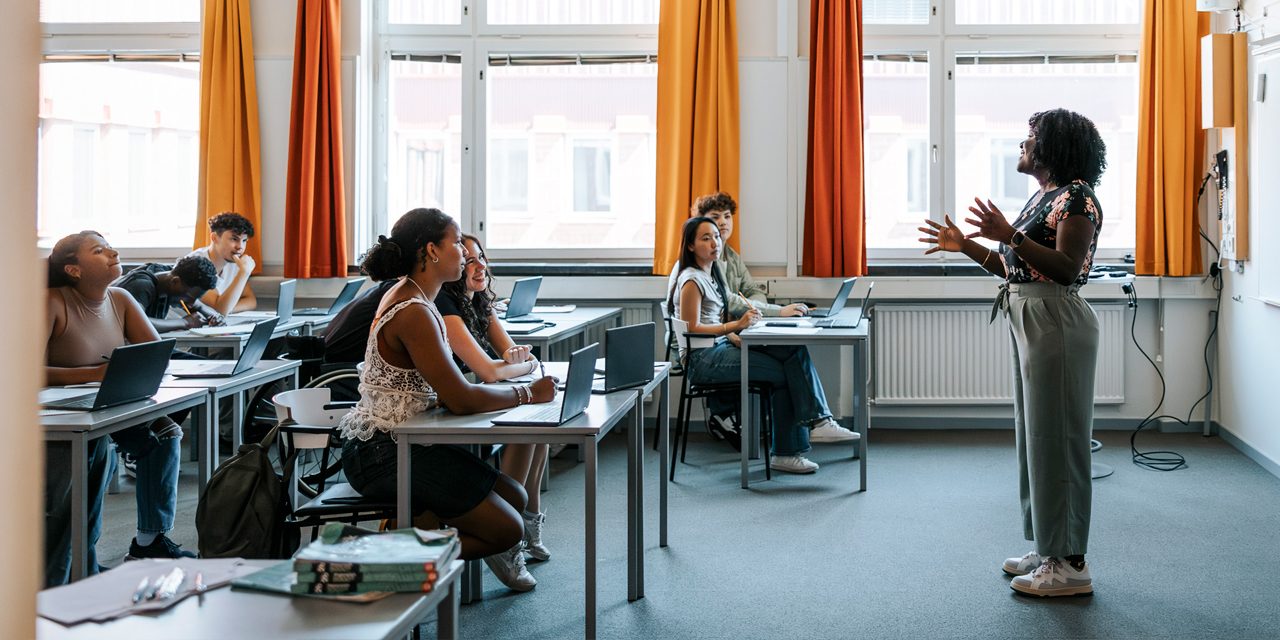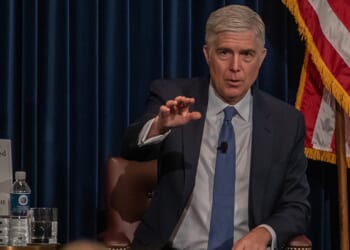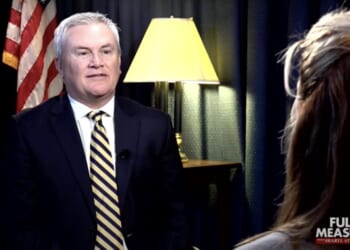
Amelia Shulman (name changed for privacy) had been teaching high school students in Georgia for three years when, in 2024, she decided it was time to consider another career. A major factor was administrators’ indifference to classroom disorder.
“Higher-ups at the school—and superintendents at the district level—are really pushing teachers to just take the path of least resistance if a kid is acting out,” Shulman said. “The goal is to have very low numbers of students facing major disciplinary action, but that doesn’t reflect what’s actually happening at the school every day.”
Finally, a reason to check your email.
Sign up for our free newsletter today.
On April 23, the Trump administration moved to change that. The president issued an executive order, “Reinstate Commonsense School Discipline Policies,” to revoke Obama- and Biden-era guidance that forced schools to ignore disorder under the guise of improving “equity” and “inclusion.”
The administration is right to act. Restoring order in America’s classrooms will require undoing years of misguided federal policies that prioritized racial quotas and therapeutic interventions. These policies have eroded academic achievement, endangered students, and made it harder for struggling kids to get the help they need. To succeed, however, the administration will need to respect local control, while overcoming fierce resistance from an entrenched education bureaucracy.
The saga begins with a 2012 report from the Obama administration that found that black students were “suspended, expelled, and arrested” at higher rates than white students. In response, the administration sent a “Dear Colleague” letter to state and local education agencies in 2014, threatening federal investigations if rates of “exclusionary discipline”—suspensions and expulsions—were racially disparate.
The “Dear Colleague” guidance presumed that racial bias accounted for the contrasting discipline rates. “Statistical and quantitative data” explaining disparities would not be enough to prevent a civil rights investigation—even if a school’s policies were race-neutral and implemented evenhandedly. America’s history of racism, the letter suggested, was enough to conclude that ongoing discrimination drove the disparities.
The guidance ignored reality. Many factors influence why discipline rates vary by race, including different levels of underlying misbehavior, which in turn can be influenced by socioeconomic status, family structure, and neighborhood characteristics, for example. Black students are three times more likely to grow up in poverty than white students, so it is unsurprising to see racial disparities in misbehavior, just as we see them in academic achievement. The 2014 guidance even acknowledged that a “range of factors” influence suspension and expulsion rates, yet it nevertheless dismissed this reality. Rather than addressing the needs of individual students, federal guidance, with its threat of investigations, simply forced schools to sweep misconduct under the rug.
How have things played out? The era of school-discipline reform has coincided with rising school shootings, school violence, classroom disorder, drug use, gang activity, bullying, and teacher attrition. Meantime, academic performance and student feelings of safety have declined, even as suspension rates have fallen. And these trends are not solely a result of the pandemic; they were documented years before.
Far from helping minority students, the Obama-era discipline reforms made things worse for them. In New York City, the greatest negative shifts occurred in schools where minorities made up over 90 percent of the student body. After similar reforms in Philadelphia, students in the most disadvantaged schools who had never been suspended themselves saw their learning outcomes decline. Learning outcomes for their prior-suspended peers showed no improvement.
“Schools are meant to prioritize teaching kids what they’re supposed to learn and shaping them into functioning members of society,” Shulman told me. “But it’s almost as if schools have turned into a kind of holding cell that kids are required to go into every day. If a student acts out, the conversation becomes, ‘Oh, the parents are going to be upset to hear about this and might push back on any kind of punishment,’ so it’s easier to just let students go about their day.”
The description of schools as “holding cells” is ironic, considering how the reforms were marketed as a way to disrupt the so-called school-to-prison pipeline.
Advocates pushed to replace the enforcing of traditional codes of conduct with “restorative practices”—faddish, pseudo-therapeutic interventions like social-emotional learning, mental-health awareness training, and kumbaya-style talking circles.
In the Obama years, Broward County, Florida, gained national fame for using such practices to reduce the school district’s law-enforcement referrals. Then, in February 2018, a 19-year-old former student of the Broward County School District perpetrated the deadliest high school shooting in U.S. history, killing 17 students and injuring 18 others at Marjory Stoneman Douglas High School in Parkland.
The shooter had been violent and extreme for years. Students recounted that he had brought bullets, knives, and dead animals to school, and had threatened to kill and rape classmates. On one occasion, a school administrator allegedly ignored evidence that the shooter called another student by a racial slur and attacked him. He was disciplined only once that semester—a two-day, in-school suspension.
After the shooting, President Trump, then in his first term, rescinded the Obama-era discipline guidance. But it was functionally reinstated under President Biden in 2023. School climate had deteriorated so badly by then, though, that even the Biden team must have known the move would be unpopular. The administration issued the guidance on the Friday before a holiday weekend, when policy changes tend to fly under the radar. The directive also used far weaker language than the original.
The Trump administration’s latest executive order lays the groundwork for ending this failed school-discipline policy for good. It not only rescinds the Biden-era guidance but goes further, reaffirming that schools must comply with federal civil rights law by addressing misconduct based on students’ behavior—not their race.
The executive order also directs the Department of Education to provide schools with model discipline policies that take a “common sense” approach—policies that “protect the safety and educational environment of students, do not promote unlawful discrimination, and are rooted in American values and traditional virtues.”
Properly understood, discipline is not merely punitive; it is also constructive. Removing violent or disruptive students from classrooms protects their peers, while documenting misconduct can help trigger appropriate interventions, such as placing problem students in specialized settings.
For students with serious behavioral problems, specialty settings can provide an opportunity to thrive. Research has documented how emotionally disturbed students enrolled in private special-education schools saw improved peer relationships and emotional maturity one year later, while those in less restrictive educational settings were unlikely to succeed.
“Exclusionary discipline” might not always improve behavior on its own, but an obsession with “inclusion” doesn’t necessarily leave students better off, either. The Parkland school shooter, for example, had been stabilized in a specialty school—but that stabilization became the justification for moving him back into the setting that had previously failed him, with tragic results.
Inclusion for its own sake often leads to lower accountability and lower expectations for everyone involved. As Shulman sees it, this means students not only miss important instruction about how to behave but also fall behind academically. “The lack of follow-through with any kind of punishment for student misbehavior seems to go hand-in-hand with passing students on to the next grade,” she says, “even if they haven’t learned what they’re supposed to learn.”
Non-disciplinary interventions can be the easy way out—a box to check for resource-strapped schools. For a student acting out because he can’t follow classroom instruction, the cheap option might be to offer accommodations, sessions with the school counselor, or even to turn a blind eye, rather than providing the needed academic support. Nor do non-disciplinary interventions communicate to students what is expected of them.
Expectations matter greatly. Studies consistently show that, when held to high standards in both academics and behavior, students rise to meet them. Even short-term, ambitious goals boost student engagement and well-being. Holding expectations high but attending to students who fail to meet them can help kids succeed, in part by directing them to the right resources and settings.
Conversely, lowering expectations reinforces poor achievement and bad behavior. This was shown during and after the pandemic with policies often defended as necessary to protect students’ mental health. Many schools, encouraged by mental health industry groups, have adopted a posture that bad behavior should be excused and standards abandoned, because students have been “traumatized” by online classes through Zoom.
These mental-health arguments against discipline are the weakest of all. Surveys show that a major source of distress among young people is fear of violence—especially fear of mass shootings. Creating safer, more orderly schools would reduce stress for the vast majority of students.
And for those who misbehave, experiencing some degree of discomfort from disciplinary consequences may help them grow. Schools are, after all, training grounds for adult life, where personal responsibility and self-control are essential. Do we want students to feel good because of bad behavior?
Learning that misbehavior carries consequences is not damaging for students—it is indispensable. “Better to teach children to behave before they leave school and face far harsher consequences for making bad decisions as adults,” writes Manhattan Institute fellow Jason Riley in the Wall Street Journal.
Trump’s executive order tasks the Department of Education with assessing the role of nonprofits and behavior-modification techniques that promote “discriminatory-equity-ideology.” The DOE will likely find that dumping federal taxpayer dollars into school-based mental health hasn’t worked. Such programs have proliferated in recent years. But as with “restorative justice,” school-based mental health often undermines teacher authority and makes it harder to deter serious misconduct.
This past fall, four people were killed in a Georgia school shooting not far from where Shulman used to teach. The young boy responsible for the shooting needed intensive inpatient psychiatric care, a scarce commodity nationwide. School-based mental health doesn’t target those with the most intense need. It focuses on general wellness, pathologizing the typical stress of adolescence. The day after the Georgia shooting, President Biden’s assistant secretary for mental health and substance use posted on X about “celebrating the transformative impact of art on recovery.” The Georgia shooter needed more serious intervention than mental-health coloring pages.
The Trump administration should proceed carefully. Federal guidance should urge states and districts to set clear, specific behavioral expectations and consequences, and to communicate them widely to students, parents, teachers, and administrators. Schools should apply discipline policies consistently and fairly, while offering students pathways to demonstrate improvement. Discipline decisions must remain under local control, subject to debate and accountability through elected school boards.
Finally, policymakers need to be realistic about the ideology embedded in today’s education system. Many school-based mental-health professionals and administrators are trained in “equity” ideology, not in the needs of individual students. Resistance to restoring real discipline will be strong.
The tide may be turning, however. After a year away from the classroom, Shulman is considering a return. “In my heart of hearts, I am a teacher,” she says. “I think a lot of people who are leaving the profession feel the same. The issues are not with being a teacher, but with the things we’re told to do and the way the schools are being run.” While we often hear about a teacher shortage, Shulman suggests that it’s really “just a shortage of people willing to put up with these policies and this management.” With the shift toward a more commonsense approach to discipline, conscientious educators may finally catch a break.
Photo: Maskot / DigitalVision via Getty Images
Source link

















